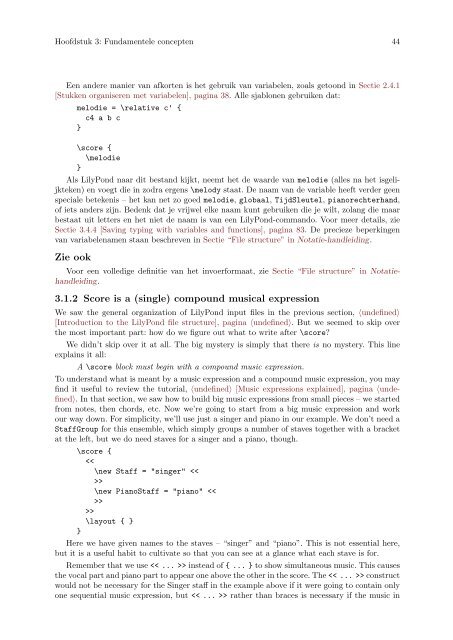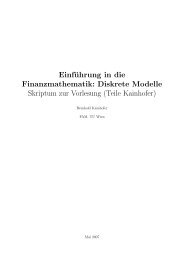LilyPond Beginnershandleiding
LilyPond Beginnershandleiding
LilyPond Beginnershandleiding
Create successful ePaper yourself
Turn your PDF publications into a flip-book with our unique Google optimized e-Paper software.
Hoofdstuk 3: Fundamentele concepten 44<br />
Een andere manier van afkorten is het gebruik van variabelen, zoals getoond in Sectie 2.4.1<br />
[Stukken organiseren met variabelen], pagina 38. Alle sjablonen gebruiken dat:<br />
melodie = \relative c' {<br />
c4 a b c<br />
}<br />
\score {<br />
\melodie<br />
}<br />
Als <strong>LilyPond</strong> naar dit bestand kijkt, neemt het de waarde van melodie (alles na het isgelijkteken)<br />
en voegt die in zodra ergens \melody staat. De naam van de variable heeft verder geen<br />
speciale betekenis – het kan net zo goed melodie, globaal, TijdSleutel, pianorechterhand,<br />
of iets anders zijn. Bedenk dat je vrijwel elke naam kunt gebruiken die je wilt, zolang die maar<br />
bestaat uit letters en het niet de naam is van een <strong>LilyPond</strong>-commando. Voor meer details, zie<br />
Sectie 3.4.4 [Saving typing with variables and functions], pagina 83. De precieze beperkingen<br />
van variabelenamen staan beschreven in Sectie “File structure” in Notatie-handleiding.<br />
Zie ook<br />
Voor een volledige definitie van het invoerformaat, zie Sectie “File structure” in Notatiehandleiding.<br />
3.1.2 Score is a (single) compound musical expression<br />
We saw the general organization of <strong>LilyPond</strong> input files in the previous section, 〈undefined〉<br />
[Introduction to the <strong>LilyPond</strong> file structure], pagina 〈undefined〉. But we seemed to skip over<br />
the most important part: how do we figure out what to write after \score?<br />
We didn’t skip over it at all. The big mystery is simply that there is no mystery. This line<br />
explains it all:<br />
A \score block must begin with a compound music expression.<br />
To understand what is meant by a music expression and a compound music expression, you may<br />
find it useful to review the tutorial, 〈undefined〉 [Music expressions explained], pagina 〈undefined〉.<br />
In that section, we saw how to build big music expressions from small pieces – we started<br />
from notes, then chords, etc. Now we’re going to start from a big music expression and work<br />
our way down. For simplicity, we’ll use just a singer and piano in our example. We don’t need a<br />
StaffGroup for this ensemble, which simply groups a number of staves together with a bracket<br />
at the left, but we do need staves for a singer and a piano, though.<br />
\score {<br />
<br />
\new PianoStaff = "piano" ><br />
>><br />
\layout { }<br />
}<br />
Here we have given names to the staves – “singer” and “piano”. This is not essential here,<br />
but it is a useful habit to cultivate so that you can see at a glance what each stave is for.<br />
Remember that we use > instead of { ... } to show simultaneous music. This causes<br />
the vocal part and piano part to appear one above the other in the score. The > construct<br />
would not be necessary for the Singer staff in the example above if it were going to contain only<br />
one sequential music expression, but > rather than braces is necessary if the music in



